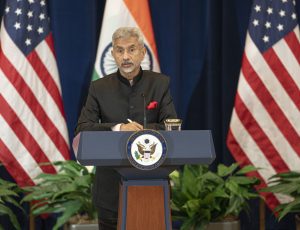Since the start of the Russia-Ukraine war India has abstained from voting 11 times whenever this issue has come up – be it the United Nations General Assembly (UNGA), the United Nations Security Council (UNSC), the United Nations Human Rights Council (UNHRC), or the International Atomic Energy Agency (IAEA).
However, India has unequivocally condemned the violence and called for the resolution of the conflict through dialogue and diplomacy. Further India has called for respecting the sovereignty and territorial integrity of all countries. India also sent humanitarian aid to Ukraine and expressed its outrage at the civilian killings in Ukraine’s Bucha, calling for an independent probe into this incident.
India has explained its abstentions as taking a neutral approach since this is not India’s war. New Delhi’s close defense cooperation with Russia prevents India from taking sides. According to the Stockholm International Peace Research Institute’s (SIPRI) report “Trends in International Arms Transfers, 2021,” India was the biggest arms importer during the period between 2017 and 2021, accounting for 11 percent of the total global arms imports. Most of those arms come from Russia. While India’s share of arms imports from Russia have dropped from 69 percent during the period between 2012 and 2016 to 46 percent in 2017-2021, Russia still remains the biggest arms supplier to India. The drop in share of imports from Russia corresponds to a simultaneous rise of defense imports from France, the United States, and Israel.
Constant security threats from China and Pakistan imply that it would take time for India to diversify its defense imports and also increase indigenous production of arms. Indeed, recently India received the delivery of the second regiment of the S-400 air defense missile system from Russia. India’s engagements with Russia, therefore, cannot be viewed entirely in a binary like the Western countries.
India and the West may have their own perspectives about the Russia-Ukraine conflict, but India is making an effort to work around the differences, while maintaining its focus on the Indo-Pacific Region. That is evident from India’s external engagements since the start of the Russia-Ukraine war. In the past two months, India has had a hectic diplomatic schedule with a flurry of high-profile meetings.
India’s engagements include visits by U.K. Prime Minister Boris Johnson, European Commission President Ursula von der Leyen Japanese, and Prime Minister Kishida Fumio; Prime Minister Narendra Modi’s virtual summits with U.S. President Joe Biden and Australian Prime Minister Scott Morrison; and the India-U.S. 2+2 Dialogue. By contrast, India’s only notable engagement with Russia was the Russian Foreign Minister Sergey Lavrov’s visit to India, and Modi’s telephonic talks with Russian President Vladimir Putin.
These engagements with the United States, Japan, Australia, the U.K., and the EU indicate India is maintaining its focus on the Indo-Pacific Region. The U.S., Japan, and Australia are members of the Quad alongside India, while the U.K. and the EU looked to extend their outreach to the Indo-Pacific Region through formulating their respective policies. India is an important partner for all of these countries in the Indo-Pacific region. For India, it is important to strengthen strategic cooperation with the like-minded countries to counter China’s aggression. India’s partnership with the Quad and other entities is necessary to bolster freedom of navigation and rules-based order in the Indo-Pacific Region.
On the other hand, India’s relations with Russia, despite being strong, do have limitations. There is little engagement between both countries outside of their defense cooperation. Fearing international isolation, Russia has tried to expand its energy ties with India by offering oil at a discounted price. It is true that India stepped up its purchase of the Russian oil since the war, but even with the increased purchases, the Russian oil only accounts for about 1 to 2 percent of India’s total oil imports. India is looking to curb even that; recently India’s top refiner, Indian Oil Corporation (IOC), excluded the Russian Urals from its latest tender.
Further, the Indian Air Force has cancelled plans to buy 48 Mi-17 V5 helicopters from Russia, though this move is said to be taken to boost the Make in India initiative. Also last month, India announced a phased import ban on 107 defense items. This ban will come into effect between December 2022 and December 2028. Several Russian defense parts such as the sub-systems for Russian weapons and platforms including T-90 and T-72 tanks, BMP-II infantry combat vehicles, warships and submarines and anti-tank missiles are among the imports that will be banned. These developments drive home the fact that India’s indigenization drive, regardless of its motivations, will inevitably have the end result of lessening India’s dependence on Russia arms.
At the moment, the end of the Russia-Ukraine war appears uncertain. However, India may have already started taking steps to maintain distance from Russia in the future, in case Russia becomes China’s junior partner after the war, as predicted by some experts. While complete detachment from Russia is impossible, India has certainly prioritized those of its strategic interests that require closer cooperation with the Western countries.
































